Page 108 of 532
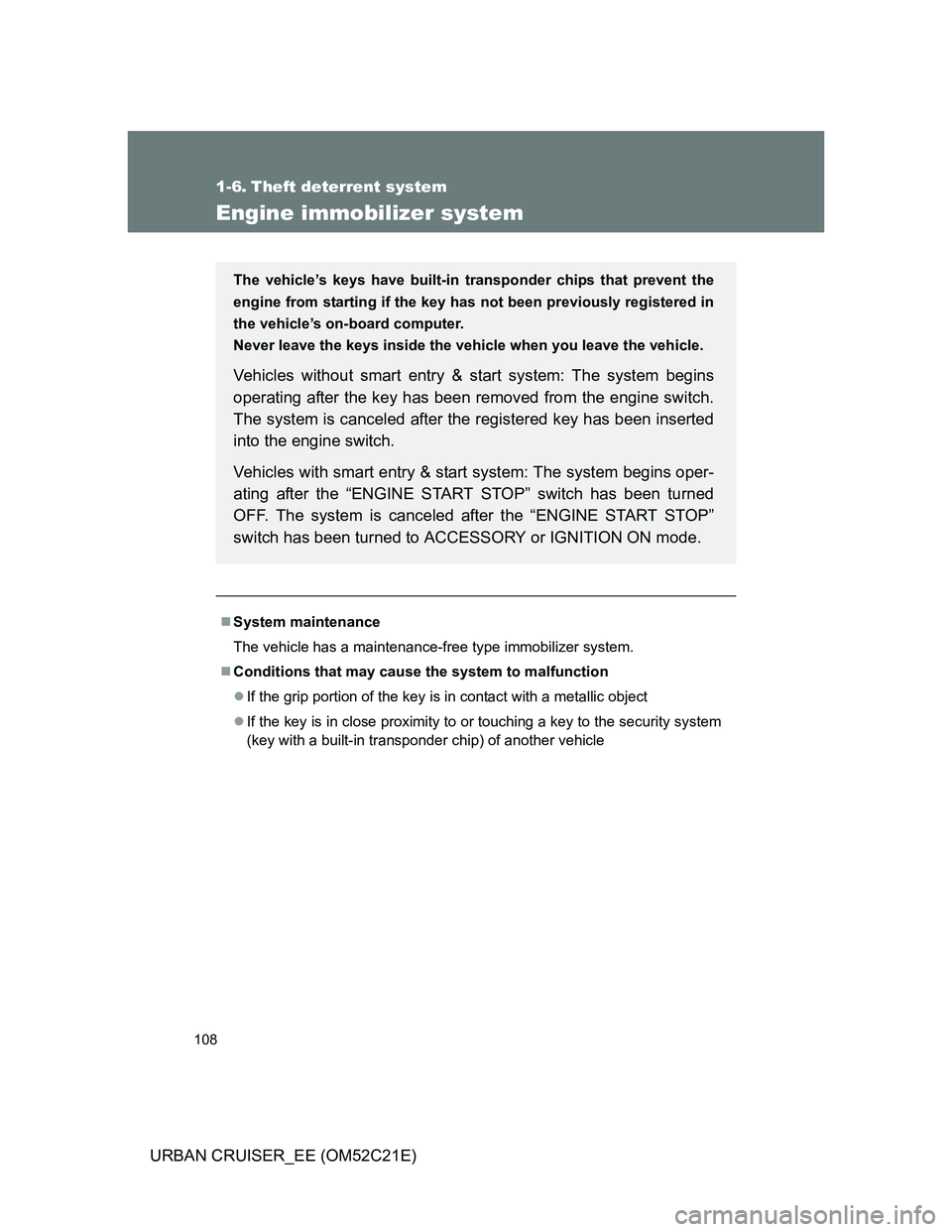
108
URBAN CRUISER_EE (OM52C21E)
1-6. Theft deterrent system
Engine immobilizer system
System maintenance
The vehicle has a maintenance-free type immobilizer system.
Conditions that may cause the system to malfunction
If the grip portion of the key is in contact with a metallic object
If the key is in close proximity to or touching a key to the security system
(key with a built-in transponder chip) of another vehicle
The vehicle’s keys have built-in transponder chips that prevent the
engine from starting if the key has not been previously registered in
the vehicle’s on-board computer.
Never leave the keys inside the vehicle when you leave the vehicle.
Vehicles without smart entry & start system: The system begins
operating after the key has been removed from the engine switch.
The system is canceled after the registered key has been inserted
into the engine switch.
Vehicles with smart entry & start system: The system begins oper-
ating after the “ENGINE START STOP” switch has been turned
OFF. The system is canceled after the “ENGINE START STOP”
switch has been turned to ACCESSORY or IGNITION ON mode.
Page 133 of 532
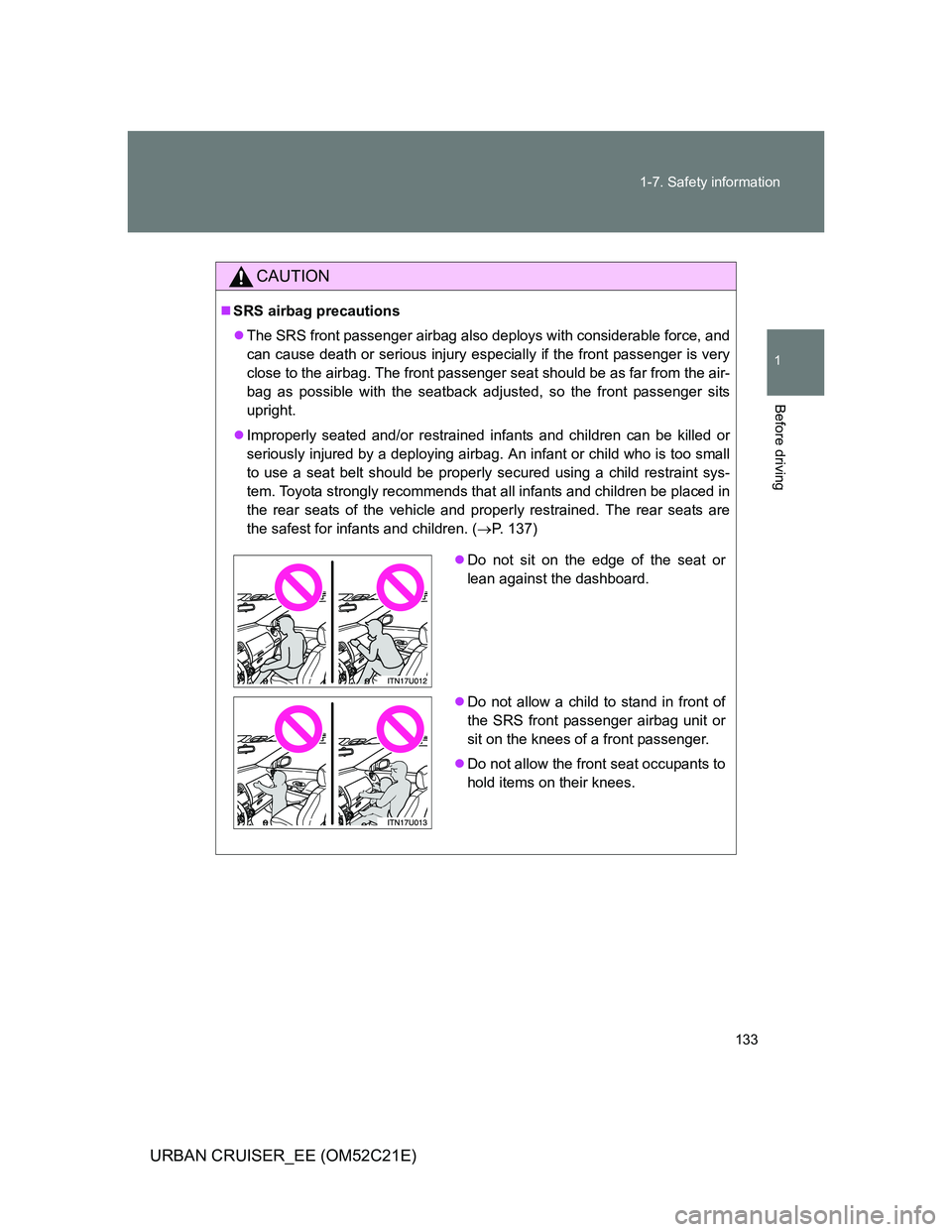
133 1-7. Safety information
1
Before driving
URBAN CRUISER_EE (OM52C21E)
CAUTION
SRS airbag precautions
The SRS front passenger airbag also deploys with considerable force, and
can cause death or serious injury especially if the front passenger is very
close to the airbag. The front passenger seat should be as far from the air-
bag as possible with the seatback adjusted, so the front passenger sits
upright.
Improperly seated and/or restrained infants and children can be killed or
seriously injured by a deploying airbag. An infant or child who is too small
to use a seat belt should be properly secured using a child restraint sys-
tem. Toyota strongly recommends that all infants and children be placed in
the rear seats of the vehicle and properly restrained. The rear seats are
the safest for infants and children. (P. 137)
Do not sit on the edge of the seat or
lean against the dashboard.
Do not allow a child to stand in front of
the SRS front passenger airbag unit or
sit on the knees of a front passenger.
Do not allow the front seat occupants to
hold items on their knees.
Page 137 of 532
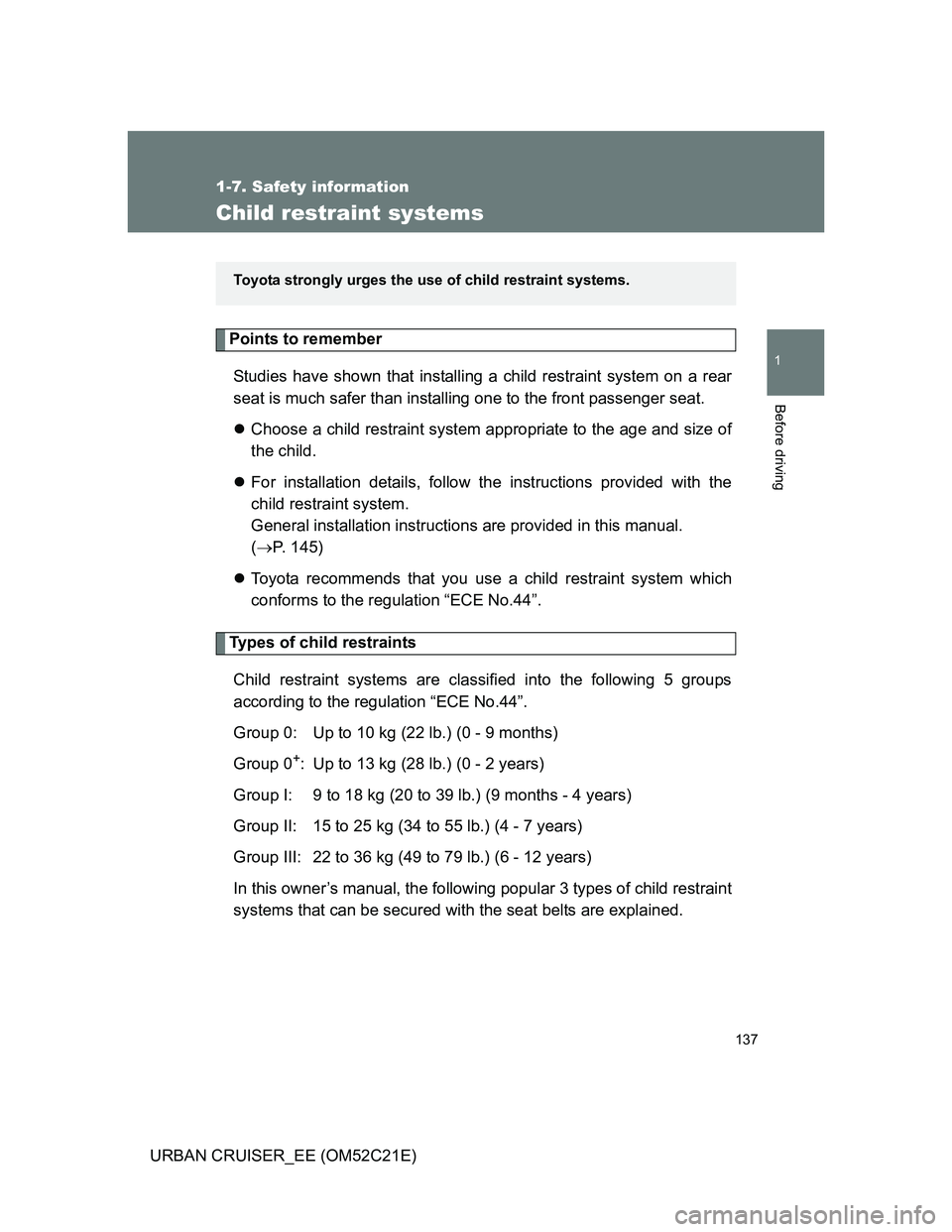
137
1
1-7. Safety information
Before driving
URBAN CRUISER_EE (OM52C21E)
Child restraint systems
Points to remember
Studies have shown that installing a child restraint system on a rear
seat is much safer than installing one to the front passenger seat.
Choose a child restraint system appropriate to the age and size of
the child.
For installation details, follow the instructions provided with the
child restraint system.
General installation instructions are provided in this manual.
(P. 145)
Toyota recommends that you use a child restraint system which
conforms to the regulation “ECE No.44”.
Types of child restraints
Child restraint systems are classified into the following 5 groups
according to the regulation “ECE No.44”.
Group 0: Up to 10 kg (22 lb.) (0 - 9 months)
Group 0
+: Up to 13 kg (28 lb.) (0 - 2 years)
Group I: 9 to 18 kg (20 to 39 lb.) (9 months - 4 years)
Group II: 15 to 25 kg (34 to 55 lb.) (4 - 7 years)
Group III: 22 to 36 kg (49 to 79 lb.) (6 - 12 years)
In this owner’s manual, the following popular 3 types of child restraint
systems that can be secured with the seat belts are explained.
Toyota strongly urges the use of child restraint systems.
Page 143 of 532
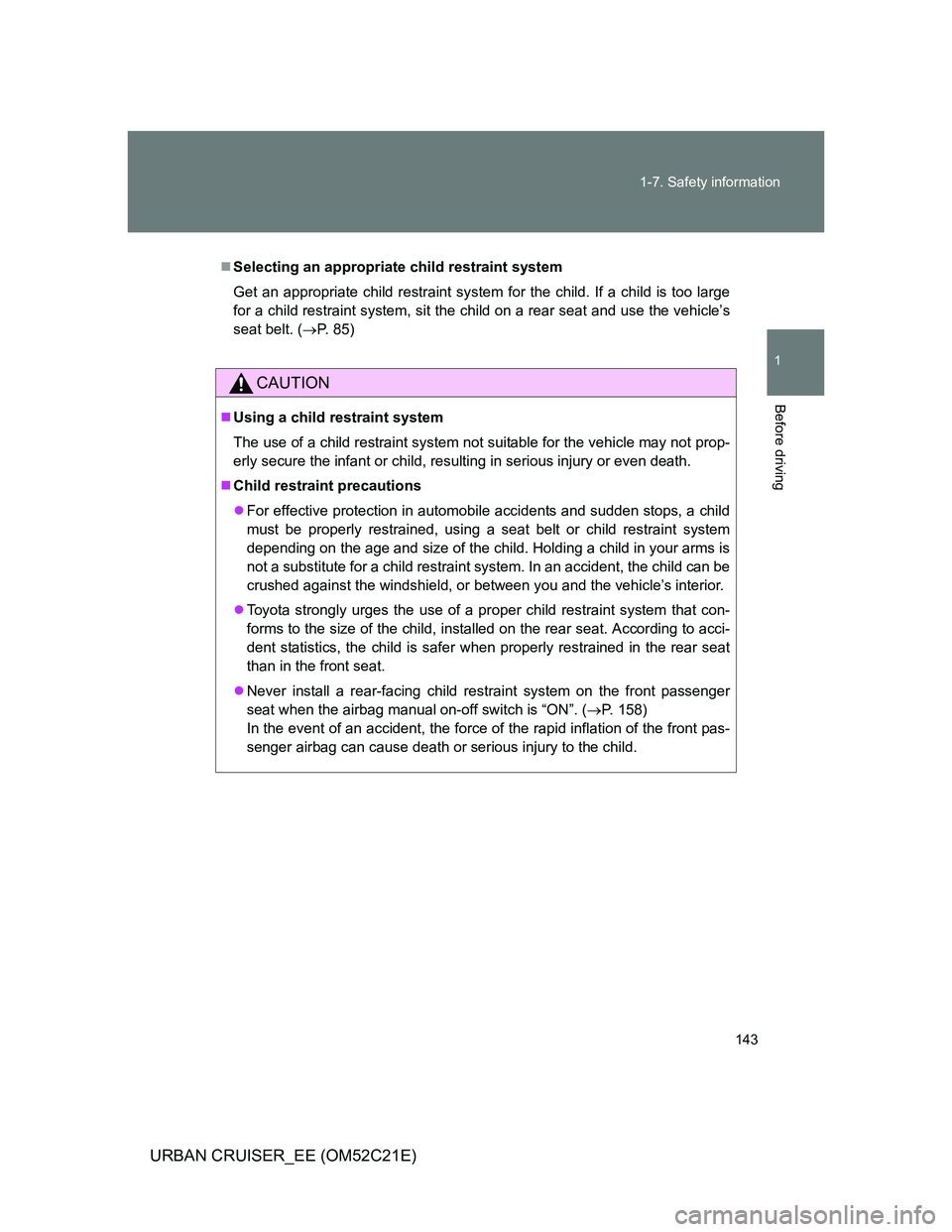
143 1-7. Safety information
1
Before driving
URBAN CRUISER_EE (OM52C21E)
Selecting an appropriate child restraint system
Get an appropriate child restraint system for the child. If a child is too large
for a child restraint system, sit the child on a rear seat and use the vehicle’s
seat belt. (P. 85)
CAUTION
Using a child restraint system
The use of a child restraint system not suitable for the vehicle may not prop-
erly secure the infant or child, resulting in serious injury or even death.
Child restraint precautions
For effective protection in automobile accidents and sudden stops, a child
must be properly restrained, using a seat belt or child restraint system
depending on the age and size of the child. Holding a child in your arms is
not a substitute for a child restraint system. In an accident, the child can be
crushed against the windshield, or between you and the vehicle’s interior.
Toyota strongly urges the use of a proper child restraint system that con-
forms to the size of the child, installed on the rear seat. According to acci-
dent statistics, the child is safer when properly restrained in the rear seat
than in the front seat.
Never install a rear-facing child restraint system on the front passenger
seat when the airbag manual on-off switch is “ON”. (P. 158)
In the event of an accident, the force of the rapid inflation of the front pas-
senger airbag can cause death or serious injury to the child.
Page 144 of 532
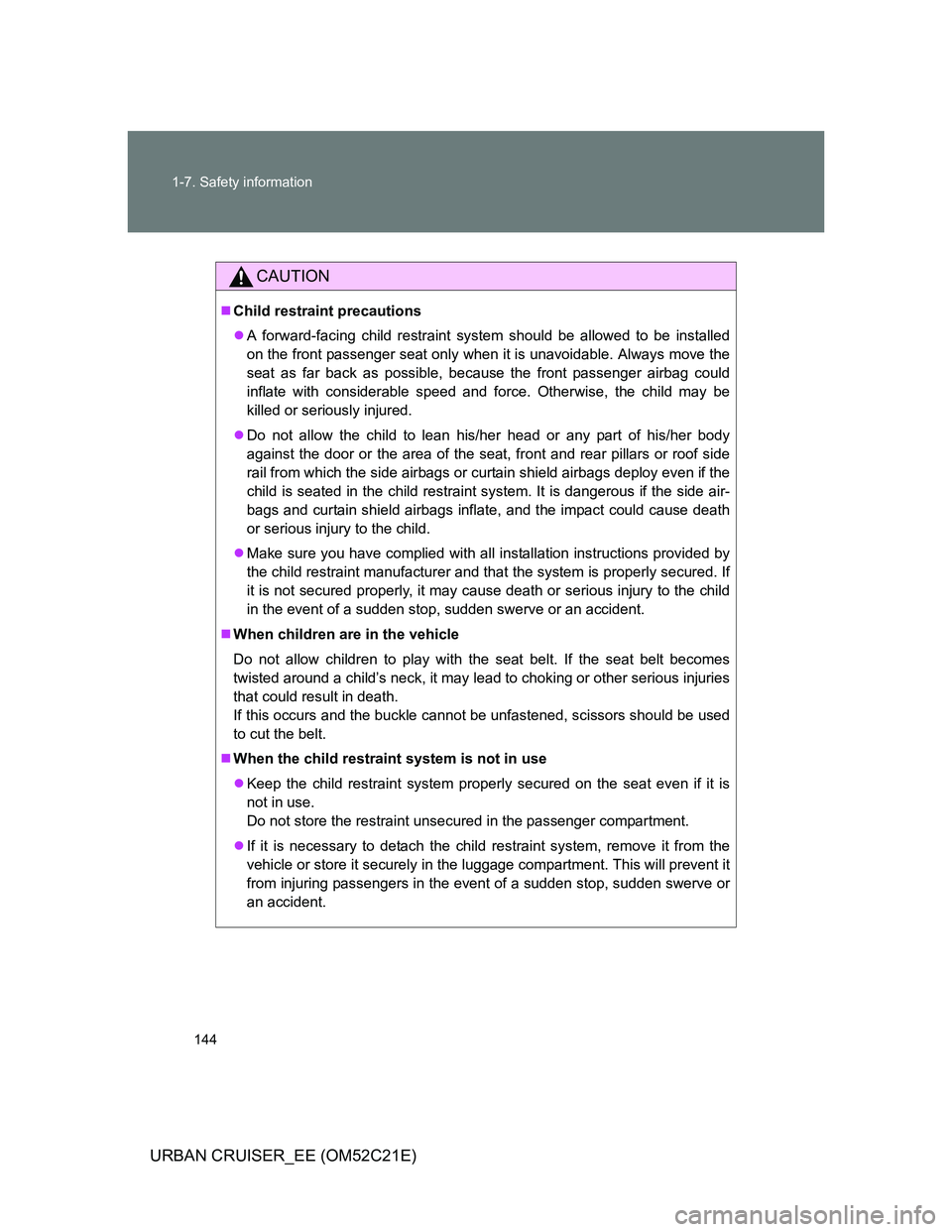
144 1-7. Safety information
URBAN CRUISER_EE (OM52C21E)
CAUTION
Child restraint precautions
A forward-facing child restraint system should be allowed to be installed
on the front passenger seat only when it is unavoidable. Always move the
seat as far back as possible, because the front passenger airbag could
inflate with considerable speed and force. Otherwise, the child may be
killed or seriously injured.
Do not allow the child to lean his/her head or any part of his/her body
against the door or the area of the seat, front and rear pillars or roof side
rail from which the side airbags or curtain shield airbags deploy even if the
child is seated in the child restraint system. It is dangerous if the side air-
bags and curtain shield airbags inflate, and the impact could cause death
or serious injury to the child.
Make sure you have complied with all installation instructions provided by
the child restraint manufacturer and that the system is properly secured. If
it is not secured properly, it may cause death or serious injury to the child
in the event of a sudden stop, sudden swerve or an accident.
When children are in the vehicle
Do not allow children to play with the seat belt. If the seat belt becomes
twisted around a child’s neck, it may lead to choking or other serious injuries
that could result in death.
If this occurs and the buckle cannot be unfastened, scissors should be used
to cut the belt.
When the child restraint system is not in use
Keep the child restraint system properly secured on the seat even if it is
not in use.
Do not store the restraint unsecured in the passenger compartment.
If it is necessary to detach the child restraint system, remove it from the
vehicle or store it securely in the luggage compartment. This will prevent it
from injuring passengers in the event of a sudden stop, sudden swerve or
an accident.
Page 145 of 532
145
1
1-7. Safety information
Before driving
URBAN CRUISER_EE (OM52C21E)
Installing child restraints
Follow the child restraint system manufacturer’s instructions. Firmly
secure the child restraints to the outside rear seats using a seat belt
or a ISOFIX rigid anchor (ISOFIX child restraint system). Attach the
top strap when installing a child restraint system.
Seat belts (An ELR belt
requires a locking clip.)
ISOFIX rigid anchor (ISOFIX
child restraint system)
These exclusive fixing bars are
provided for the outside rear
seats. (Buttons displaying the
location of the anchors are
attached to the seats.)
Page 147 of 532
147 1-7. Safety information
1
Before driving
URBAN CRUISER_EE (OM52C21E)
Installing child restraints using a seat belt
Rear-facing Baby seat/child seat
Fold the seatback while pulling
the seatback angle adjustment
lever up. Return the seatback
and secure it at the first lock
position (most upright position).
(P. 7 6 )
Place the child restraint system
on the rear seat facing the rear
of the vehicle.
Run the seat belt through the
child restraint system and insert
the plate into the buckle. Make
sure that the belt is not twisted.
Keep the lap portion of the belt
tight.
STEP1
STEP2
STEP3
Page 148 of 532
148 1-7. Safety information
URBAN CRUISER_EE (OM52C21E)Install a locking clip near the tab
of the lap and shoulder belt by
inserting the lap and shoulder
webbing through the recesses of
the locking clip.
Forward-facing Child seat
Fold the seatback while pulling
the seatback angle adjustment
lever up. Return the seatback
and secure it at the first lock
position (most upright position).
(P. 7 6 )
Place the child restraint system
on the seat facing the front of the
vehicle.
STEP4
STEP1
STEP2